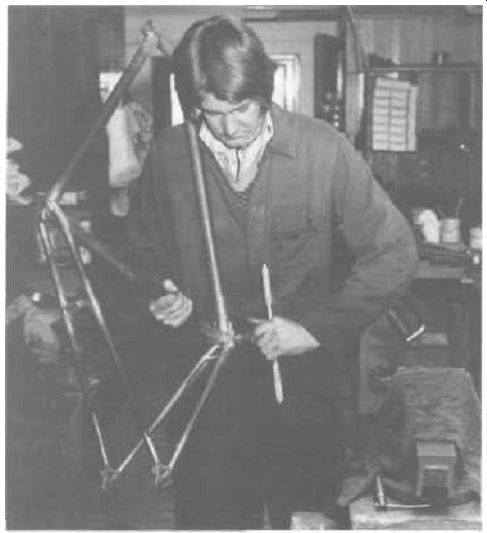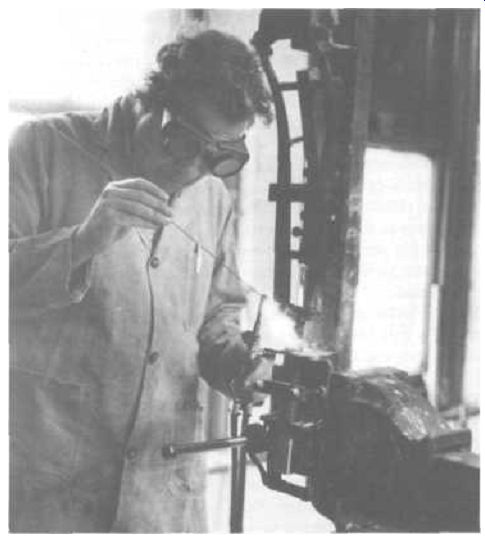Bob Jackson Cycles
JRJ Cycles, Limited 148 Harehill Lane Leeds LS8 5BD, England
Although its official name is JRJ Cycles, Limited, the firm is better known as Bob Jackson Cycles. It is located in Leeds, a city of 490,000 in the northern half of England. Leeds has been the center of the wool industry in England since the Middle Ages. Today this Yorkshire city has a diversified industrial base which gives it an interesting mixture of modern and Victorian architecture. Amidst this architectural grandeur is a small, unobtrusive building on Harehill Lane which sells lightweight bicycles, parts, and accessories.
Upon entering this small store, you are surrounded by a large array of well-displayed Reynolds 531DB framesets, most of them bearing the Bob Jackson or Merlin labels. The display area in the store is small, but the merchandise is very well organized.
Everything has been dusted and polished and sits neatly in place.
At the front right corner of the showroom is a door that marks the entrance to Bob Jackson's office. Here you'll find a tidy, well-lit room with two desks-one for Mr. Jackson and one for his administrative secretary. Behind the large desk where Bob Jackson sits is the door leading to the frame-building shop. On the wall behind Bob's desk hangs a picture of Jacques Pinto, an American bicycle distributor, with former U.S. President Gerald Ford. The picture is signed by Mr. Ford with a note of thanks for the bicycle that Bob Jackson had built for him.
Background Bob Jackson bicycles gained popularity in the United States during the bicycle boom of the late 1960s through the early 1970s. His frames are beautifully finished and, during the bicycle boom, seemed to be more easily available than some of his competitors. His fame grew, in part, as a result of his paint jobs. Each frame goes through a seven-process paint job which is baked 40 minutes each time. (This is where they derive the name stove enamel finish.) Each frame receives a special rust-proofing and primer. Bob Jackson specializes in flamboyant, polychromatic, and enamel paint finishes.
Bob Jackson presently employs four frame builders who receive assistance from two apprentices, and one painter with one painting apprentice. This crew can produce about 25 to 40 frames per week. In 1977, 1,750 Bob Jackson and Merlin frames were built.
Bob Jackson started his own business in 1936, after having worked in the bicycle trade in the north of England. His interest in bicycle frame building resulted from his interest as a bicycle rider.
He first started cycling, and racing, in 1929 and subsequently worked for small bicycle builders in Leeds and in Manchester. He learned the most, however, from a frame builder in Manchester called L. H. Brooks. The firm of L. H. Brooks is still in Manchester, but they haven't built bicycle frames since World War II when Mr. Brooks sold his business and emigrated to Canada.
After World War II, Bob Jackson tried to expand his business by opening another shop. He went into partnership with another bicycle enthusiast, Stephen Maurice Woodrup, in 1948. Woodrup and Jackson opened up a store in the Hyde Park section of Leeds, but the partnership was not successful. It was soon dissolved, and by 1952, Woodrup frames were being built by Stephen Maurice Woodrup; Bob Jackson and Merlin frames are being built by JRJ Cycles, Limited.
Building Philosophy Bob Jackson is a sentimentalist of sorts and this is the reason he builds frames with Merlin decals. As a young man, Bob Jackson rode and raced on Merlin bicycles. Merlin was a custom bicycle builder in London whose reputation can be traced to 1912. When Merlin retired, Bob Jackson didn't want the Merlin name to die away and bought the rights to it.

Figure 5-1: "Cleaning" the bottom bracket. Note tool used for
this procedure (see figures 3-5 and 3-6 in section
3).
Bob Jackson is considered an artisan in his trade. When he was asked how long he thought it takes to become a competent frame builder, he (like most frame builders) found the question to be difficult to answer. He feels that it takes years of hard work to become a really skilled builder, especially if the frame builder intends to be able to build to individual specifications. Tubes have to be mitered at the right angles, tube lengths have to be cut precisely, bracket height has to be established accurately, and clearances have to be considered for the type of brakes and wheels being used. Bob Jackson feels that it takes a frame builder years before he can alter a specification in midstream without making a "mess of the whole frame." Bob Jackson no longer builds bicycle frames himself. He is the director of his firm and only makes sure that things are done to his satisfaction. The small detail work and the day-to-day problems encountered in a frame-building shop are handled by John Foster, Bob Jackson's chief frame builder.
John Foster has been building frames for Bob for over 25 years. Originally, John learned how to build frames from a frame builder called Maclean. This was before World War II and Maclean, like so many English builders of the 1920s, went out of business by the late 1950s. Because of John Foster's experience, he is the only one in the firm who builds Reynolds 753 frames.
The Reynolds 753 frames at Bob Jackson are silver-soldered with a rod consisting of 40 percent silver. This same brazing rod is used for the Reynolds 531SL frames that are built there also.
Although some builders feel that bronze can be used on the Reynolds 531SL, all agree that there is no alternative with Reynolds 753. Consequently, if you buy a Bob Jackson or Merlin frame, it will be brazed with bronze unless it is of Reynolds 531SL or Reynolds 753. If you do desire one of the Jackson frames made out of 531SL or 753, be prepared to use metric-size components because the tubes that are being used here are all metric.
As far as Reynolds 753 is concerned, currently Raleigh is the only frame manufacturer that has imperial sizes and varied gauges of the tubing available. This is because Gerald O'Donovan at TI Raleigh helped develop the imperial-size tubing.
Bob Jackson and other builders of Reynolds 753 have been limited to metric-size tubing, in only one gauge. However, this may soon change as TI Reynolds continues to expand their line of sizes available. Presently, if you do buy a Reynolds 753 Bob Jackson, they recommend that you use it for light touring (without packs) or for time trialing. The available gauge of tubing is certainly too light for riding on Belgian cobbles or through the mountains with heavy touring packs.
At Bob Jackson, all frames are built entirely without the help of jigs. They do use jigs for the construction of forks, as is common practice. The frames are tacked before they are brazed and they are worked on, from start to finish, by one builder with the help of an apprentice.
Frame Selection
You can get a frame from Bob Jackson with many different options. They now use what is called the oversize Reynolds Continental fork section which has only been available to them from Reynolds in the last few years (on Reynolds 531SL and Reynolds 753 only). They do have cast lugs available, but they try not to use them anymore. Bob Jackson claims that the wall thicknesses are never equal on the cast lugs which creates problems when brazing since they must apply more heat at the thicker part of the lug in contrast to less heat on the thinner part.

Figure 5-2: Builder brazing the fork crown at JRJ Cycles.
All in all, Bob Jackson finds the quality of the pressed steel lug far superior to the cast lug.
Don't expect your Bob Jackson to have thinly filed lugs as Bob feels that when the lugs are filed down too thin "they're simply taking away the whole strength of the frame." For him, a lug must only be filed until it is uniformly thick and clean all over.
You can order your Bob Jackson with a cast bottom bracket, but here again Bob prefers not to use cast bottom brackets because he thinks they are poorly finished. He would prefer to use the pressed steel bottom bracket which he feels is clean and uniform in wall thickness.
Fork crowns on Bob Jackson frames are predominantly forged. You can order either a semi-sloping, fully sloping, or flat crown. Bob Jackson doesn't think that the style of the fork crown makes any difference as far as the handling of the bicycle is concerned. He believes the reasons for the varying designs are primarily decorative. He does think that there is a difference in strength, especially with the "Cinelli-type" fork crowns which he says are exceptionally strong. In many cases, he feels that it might be too strong in front impact crashes which can pretzel the fork blades and frame tubes without damaging the crown at all.
Seatstay diameters can be ordered to suit. In Bob's opinion, the 5/8-inch diameter stays are a result of fashion only. He feels that they are just as strong as the 9/16 inch or the 1/2 inch, provided the gauge is the same. He doesn't think that there's a great deal of stress on the seatstays, so that the diameter of the stay is not going to make any difference.
Different seat cluster arrangements are available with a Bob Jackson frame. The full wrap, semi-wrap (chamfered), and the fastback arrangements are all available except on the Reynolds 753, on which you'd get either chamfered or capped clusters.
This is because of the heat problem encountered when working with such light tubing. Bob thinks that the wrapover stay is the strongest when using regular Reynolds 531DB.
If you decide you want a Bob Jackson frame, JRJ Cycles, Limited, will build to your specifications. They are willing to build just about anything you want. Bob Jackson cautions the American consumer in particular not to order oversize frames. He is continually amazed as he receives orders from 5'6" customers who order a 24-inch frame.
For reasons we are unable to explain, Bob Jackson frames are somewhat controversial. We interviewed many people who felt that his frames suffered from several undefined [and sometimes mysterious) maladies. This is particularly interesting since virtually everyone rated the overall finish of the framesets as first class.
Moreover, our interview with Mr. Jackson revealed that he is extremely conscientious, organized, and knowledgeable.